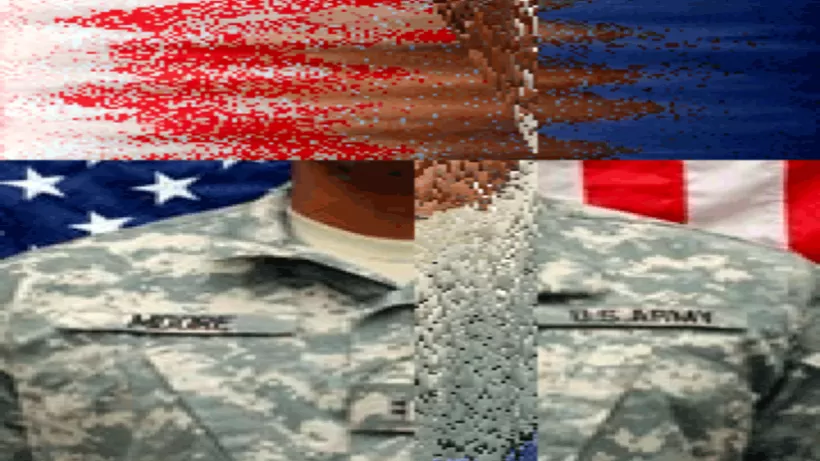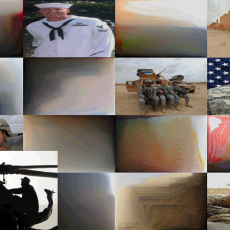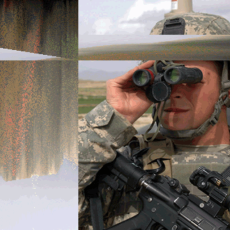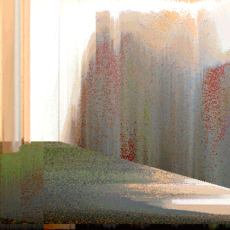There is a new archive of photography, and the photograph itself is changed. The archive is the structured columnar accumulation of endless banality to which any- and everyone contributes, and from which we all can also retrieve at will, and through those same worn channels, not just the singular image, but a stream of categorical similitude. Meanwhile, the photo–properly, no longer the "photo," but simply the more generic "image"–in order to accommodate the new regime, has been fractured into bits in a grid: the emulsive indexicality of photography has been exchanged for an information dense field divorced from referential imperative. The over-heated image economy subjects us to an overwhelming swirl of pictures, all competing for our attention, and demanding iconic recognition for the ideas and the entities for whom they act as agent.
In this maelstrom, the poor subjects of visual assault struggle to search, sort, and sense for the images that can orient them in the world. Will the categories of the old regimes (e.g. the opposition of studium and puctum) be of any use; or are they hopelessly bound by the material and epistemological conditions of the old regime? How else might we understand the ordering of these images in our cultures, or in our minds? Should we look to the virtual minds we have created, which, after all, are only externalizations of our thoughts that we have set inside machines, and then used like buckets to hold everything that we cannot bear to hold in our heads?
Each image is assigned a place, a spacio-temporal location, and a political one. We reorder the pictures, the diagram of our place in relation to the law; it gives us a feeling about the war, about our government, about how we are constituted in relation to the law, about our proximity to, or responsibility for, the carceral. We chart these relations as a law of ordering: the relation of law to order. Putting the images in order–placing each in its place–we must contemplate simultaneously what we are inside of and why. How have things been color-coded and tagged?
There is an orange which sets us inside of Guantanamo, and a certain kaki that puts us on one side of a barrel, while another color puts on the other. But there is no single system which produces all orderings; a multiplicity of rules simultaneously order and reorder the field. The multiple semantic overlays of image as tags recognize then abstract and separate elements of image: content and characteristic. Iconic significations link image fractions with conventional figurations–to a cultural repository of associations: with brands, experiences, feelings … Coke, terror, Nike, our troops … victimizations, enthusiasms, hagiographics, desires, heroizations, …
Here, there is a working through of the image as the result of a competition between different rules of ordering: it is a war between war and peace. Embedded, official, commercial, and unauthorized images of war and anti-war compete for iconicity and attention as they circulate and settle into sedimentary strata within the networks of electronic mediation. The semantic fields vie with content-neutral informational schema for the authority to regulate the ordering of image.
Semantic criteria lend themselves to use at the level of the image (sub-image division is also possible). But informational schema are applicable at every level down to the atomic pixel (and even lower). There are millions perhaps billions of possible orderings. The horizontal rule competes against the vertical one. It is possible that they come to a kind of accommodation, but the original image is obliterated–torn apart. Some pixels never find a place where they are not caught up in the struggle between the different orderings.
In the end, the image's referential quality is gone, but all the pixels, the color information, is preserved. The pixels' locative information is destroyed by the imposition of new sets of rules. What was figurative, is now resolutely abstract. There is no possible return to the image, but it is still present, if in a different way. What is that way? What is that presence which remains. What kind of trace is it? Does it speak to anything other than the generic constitution of image within the digital regime?
There is a violence in the reduction of image–not to mention of the human–to mere information. This violence stands to the side of a violence where the human is reduced to its bare state; to the utter subjection of the stateless refugee without legal standing, or the imprisoned enemy combatant. They are beyond a certain conventionality of rights and civility, but not beyond the imposition of certain logics of forced migration, interrogation, incarceration, and torture. It is a different nomic regime, but it has its rules; it is constituted, enacted, "run" on bodies. The horror, that we witness now in images, is just that being subject to rules which is both arbitrary and instrumental. These are rules that are difficult to make visible, even though they are often rules of visibility.
Does it make sense to make sense of those rules using tools which operate in a like manner. Or, does it reproduce the dumb blankness that overtakes me as I review those images, and reorder them in a vain attempt to understand what it is I am seeing. Somehow, in that intimate recirculation of some fraction of the archive, I arrive at ideas about images. I process them, I store them, erase them, efface them. The program, however, maintains its ignorance in relation to the images–the machine is in a space beyond meaning. It has data, and it has space–it can move a thing from one place to another. It is outside, however, the consideration of agency or its lack.
The machine is the human made thing. And software which follows an ordering that transforms the human visage to pure information is a kind of evil algorithm. Perhaps the difference of one of these orderings from another is insignificant. Any ordering that erases humanness, is an ordering of violence: one no more or less violent than another. All orderings are un-orderable in any meaningful way.
The Rules
- Retrieve at random of selection of images from Flickr.com which are included in photo pools dedicated to the topics of war and peace.
- Select a group of images which share the same tag irregardless of which pool they were from.
- Place the images in a Grid.
- Calculate the average color of each image.
- Arrange the images in the grid according to two different randomly chosen color orders: one for the horizontal dimension, and one for the vertical.
- Select each of the image in turn.
- Arrange the pixels in the image according to two different randomly chosen color orders: one for the horizontal dimension, and one for the vertical.
- Repeat




